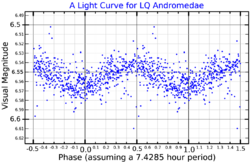Astronomy:LQ Andromedae
| Observation data Equinox J2000.0]] (ICRS) | |
|---|---|
| Constellation | Andromeda |
| Right ascension | 23h 58m 46.4391s[2] |
| Declination | +46° 24′ 47.44272″[2] |
| Apparent magnitude (V) | 6.50 – 6.66 variable[3] |
| Characteristics | |
| Spectral type | B4Ven[3] |
| Apparent magnitude (U) | 5.84[4] |
| Apparent magnitude (B) | 6.444[5] |
| Apparent magnitude (V) | 6.538[5] |
| Apparent magnitude (G) | 6.4666[2] |
| Apparent magnitude (J) | 6.588[6] |
| Apparent magnitude (H) | 6.617[6] |
| Apparent magnitude (K) | 6.545[6] |
| B−V color index | 0.098[7] |
| Variable type | Be star |
| Astrometry | |
| Radial velocity (Rv) | −51.27±0.42[8] km/s |
| Proper motion (μ) | RA: 15.419±0.081 [2] mas/yr Dec.: 0.574±0.060[2] mas/yr |
| Parallax (π) | 2.4169 ± 0.0519[2] mas |
| Distance | 1,350 ± 30 ly (414 ± 9 pc) |
| Orbit | |
| Period (P) | 7.413 days[9] |
| Details[7] | |
| Mass | 7±1[10] M☉ |
| Radius | 4.8±0.6[10] R☉ |
| Luminosity (bolometric) | 2,559 L☉ |
| Surface gravity (log g) | 3.49±0.37 cgs |
| Temperature | 17260±520 K |
| Rotational velocity (v sin i) | 300±25 km/s |
| Other designations | |
| Database references | |
| SIMBAD | data |
LQ Andromedae (shortened as LQ And, also known as HR 9070 in the Bright Star Catalogue) is a variable star in the constellation Andromeda. Its maximum apparent visual magnitude is 6.5, placing it at the limit of the visibility to the naked eye. The brightness, however, drops down to 6.66 with a periodic cycle of roughly 7.44 hours.[3]
The stellar classification of this star is B4Ven,[3] so it is a main sequence star that shows emission lines and broadened absorption lines induced by the fast projected rotational velocity of 300 km/s (the angle between the rotation axis and our line of sight has been estimated with a value of 72°).[7] This leads to the classification of the star as a Be star. Further proof is the compatibility between the rotational and luminosity variability periods.[9]
LQ Andromedae is also a spectroscopic binary with an orbital period of 7.413 days. Not much is known about the secondary component, but it is likely a low-mass companion (M<0.5 M☉). A circumstellar disk is also present in the system.[9]
References
- ↑ Harmanec, P.; Matthews, J. M.; Božić, H.; Pavlovski, K.; Huang, L.; Guo, Z. H.; Percy, J. R.; Plume, R. et al. (February 1991). "Properties and Nature of Be Stars. 15. Light Variations of LQ And and Its Check Stars Revisited". Bulletin of the Astronomical Institute of Czechoslovakia 42: 1. Bibcode: 1991BAICz..42....1H.
- ↑ 2.0 2.1 2.2 2.3 2.4 2.5 Brown, A. G. A. (August 2018). "Gaia Data Release 2: Summary of the contents and survey properties". Astronomy & Astrophysics 616: A1. doi:10.1051/0004-6361/201833051. Bibcode: 2018A&A...616A...1G. Gaia DR2 record for this source at VizieR.
- ↑ 3.0 3.1 3.2 3.3 LQ And, database entry, Combined General Catalog of Variable Stars (GCVS4.2, 2004 Ed.), N. N. Samus, O. V. Durlevich, et al., CDS ID II/250 Accessed on line 2018-10-17.
- ↑ "LQ And". SIMBAD. Centre de données astronomiques de Strasbourg. http://simbad.u-strasbg.fr/simbad/sim-basic?Ident=LQ+And.
- ↑ 5.0 5.1 Høg, E.; Fabricius, C.; Makarov, V. V.; Urban, S.; Corbin, T.; Wycoff, G.; Bastian, U.; Schwekendiek, P. et al. (2000). "The Tycho-2 catalogue of the 2.5 million brightest stars". Astronomy & Astrophysics 355: L27–L30. Bibcode: 2000A&A...355L..27H.
- ↑ 6.0 6.1 6.2 Cutri, Roc M.; Skrutskie, Michael F.; Van Dyk, Schuyler D.; Beichman, Charles A.; Carpenter, John M.; Chester, Thomas; Cambresy, Laurent; Evans, Tracey E. et al. (2003). "VizieR Online Data Catalog: 2MASS All-Sky Catalog of Point Sources (Cutri+ 2003)". CDS/ADC Collection of Electronic Catalogues 2246: II/246. Bibcode: 2003yCat.2246....0C. http://vizier.u-strasbg.fr/viz-bin/VizieR?-source=II/246.
- ↑ 7.0 7.1 7.2 Zorec, J.; Frémat, Y.; Domiciano de Souza, A.; Royer, F.; Cidal, L.; Hubert, A. -M.; Seemann, T.; Martayan, C. et al. (2017). "Critical study of the distribution of rotational velocities of Be stars. I. Deconvolution methods, effects due to gravity darkening, macroturbulence, and binarity". Astronomy & Astrophysics 595: 26 pp. doi:10.1051/0004-6361/201628760. Bibcode: 2016A&A...595A.132Z.
- ↑ de Bruijne, J. H. J.; Eilers, A.-C. (October 2012). "Radial velocities for the HIPPARCOS-Gaia Hundred-Thousand-Proper-Motion project". Astronomy & Astrophysics 546: 14. doi:10.1051/0004-6361/201219219. A61. Bibcode: 2012A&A...546A..61D.
- ↑ 9.0 9.1 9.2 Matthews, J. M.; Harmanec, P.; Walker, G. A. H.; Yang, S.; Wehlau, W. H. (February 1991). "Spectroscopic variations of the Be star LQ And : binarity and rotation.". Monthly Notices of the Royal Astronomical Society 248 (4): 787–803. doi:10.1093/mnras/248.4.787. Bibcode: 1991MNRAS.248..787M.
- ↑ 10.0 10.1 Vieira, R. G.; Carciofi, A. C.; Bjorkman, J. E.; Rivinius, Th.; Baade, D.; Rímulo, L. R. (2017). "The life cycles of be viscous decretion discs: Time-dependent modelling of infrared continuum observations". Monthly Notices of the Royal Astronomical Society 464 (3): 3071–3089. doi:10.1093/mnras/stw2542.
 |


